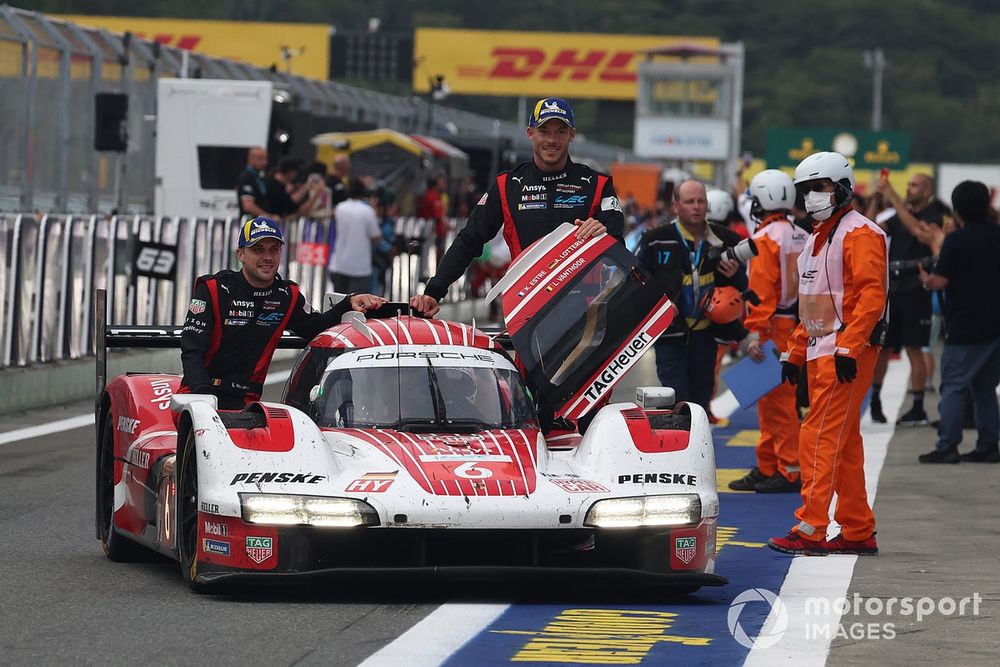Porsche Penske Motorsport could modify its plan to run just two drivers in the regular six-hour World Endurance Championship races next year.
The team will go into its 2025 WEC campaign with a “flexible approach” after opting to downsize from three to two drivers in each of the factory Porsche 963 LMDhs, PPM managing director Jonathan Diuguid has revealed to Motorsport.com.
That could involve the WEC squad drafting in drivers from its IMSA SportsCar Championship operation if it feels that a three-driver roster makes sense for certain tracks.
Mathieu Jaminet and Matt Campbell are scheduled to bolster the regular WEC crews for the Le Mans 24 Hours centrepiece round of the series as well as the 10- and eight-hour races in Qatar and Bahrain that bookend the season.
They will respectively join Michael Christensen and Julien Andlauer in the #5 963 and Laurens Vanthoor and Kevin Estre in #6.
“We have significant flexibility how we approach the season,” explains Diuguid.
“There is only one conflict, which is Spa [and Laguna Seca in May], and outside of that if we think it was the wrong decision for tracks A, B or C, we can go back to three drivers pretty easily.”

Race winner #6 Porsche Penske Motorsport Porsche 963: Kevin Estre, Andre Lotterer, Laurens Vanthoor
Photo by: JEP / Motorsport Images
Diuguid pointed to the Austin round in September as a potential race at which bringing in a third driver is a possibility because of likely hot conditions.
He explained that Penske’s “one-team” approach across the WEC and IMSA gives it this flexibility and was also a key factor in its decision to go to two drivers for five of the eight WEC rounds next year.
For that reason Diuguid believes that PPM will not be compromised at Le Mans, as well as at Qatar and Bahrain, when a third driver is added.
“A big part of our decision is that we are one global operation,” said Diuguid.
“All of our drivers know all of the engineers and processes, and the cars and tyres are the exact same with the exception of a few small aero differences [resulting from the different windtunnels used for homologation in the two series].
“It is not as though we are taking someone from an LMP2 and putting them in the car — it will be someone who is used to racing the 963.”
Diuguid suggested that PPM would not have opted for line-ups of just two permanent drivers if this option wasn’t available to it.
“If PPM was only racing in the WEC I don’t think we would have taken this decision; going in with only two drivers per car would probably not have been the right thing to do because you would have to bring someone in for Qatar, Le Mans and Bahrain and get them up to speed,” he said.
“But because we are racing in IMSA that isn’t a problem.”
Diuguid explained that running just two drivers offers an incremental gain “as the WEC gets tighter and tighter”.
“We think there is a gain to be made because there is always a set-up compromise with three drivers,” he explained.
“Now we will only have to have two drivers run through our long-run tyre plan to understand the degradation profiles.
“We will be able to prepare for the race a lot better with the information we have.”
Porsche has followed the lead set by the Ganassi Cadillac team, which fielded Earl Bamber and Alex Lynn as a duo in its single V-Series.R for the shorter WEC races this year.
There was a move led by BMW to mandate three-driver line-ups for all WEC races in the Hypercar division, which was rejected by a majority of participants.
The Jota team that has taken over the factory Cadillac programme is expected to run three drivers in each of its V-Series.Rs next year, while it is unclear if any other manufacturer will opt for two drivers for the six-hour races.








